[English] 日本語
 Yorodumi
Yorodumi- PDB-1y0j: Zinc fingers as protein recognition motifs: structural basis for ... -
+ Open data
Open data
- Basic information
Basic information
| Entry | Database: PDB / ID: 1y0j | ||||||
|---|---|---|---|---|---|---|---|
| Title | Zinc fingers as protein recognition motifs: structural basis for the GATA-1/Friend of GATA interaction | ||||||
 Components Components |
| ||||||
 Keywords Keywords | DNA BINDING PROTEIN / zinc finger / GATA-1 / FOG / protein-protein complex | ||||||
| Function / homology |  Function and homology information Function and homology informationlymph gland plasmatocyte differentiation / lymph gland crystal cell differentiation / negative regulation of hemocyte differentiation / amnioserosa maintenance / positive regulation of antibacterial peptide biosynthetic process / regulation of primitive erythrocyte differentiation / basophil differentiation / eosinophil fate commitment / regulation of definitive erythrocyte differentiation / germ-band shortening ...lymph gland plasmatocyte differentiation / lymph gland crystal cell differentiation / negative regulation of hemocyte differentiation / amnioserosa maintenance / positive regulation of antibacterial peptide biosynthetic process / regulation of primitive erythrocyte differentiation / basophil differentiation / eosinophil fate commitment / regulation of definitive erythrocyte differentiation / germ-band shortening / larval lymph gland hemopoiesis / Factors involved in megakaryocyte development and platelet production / lymph gland development / RUNX1 regulates genes involved in megakaryocyte differentiation and platelet function / compound eye development / regulation of glycoprotein biosynthetic process / chaeta development / myeloid cell apoptotic process / primitive erythrocyte differentiation / megakaryocyte differentiation / osteoblast proliferation / cell development / RUNX1 regulates genes involved in megakaryocyte differentiation and platelet function / Sertoli cell development / RUNX1 regulates transcription of genes involved in differentiation of HSCs / dendritic cell differentiation / cellular response to follicle-stimulating hormone stimulus / negative regulation of bone mineralization / Factors involved in megakaryocyte development and platelet production / negative regulation of myeloid cell apoptotic process / positive regulation of mast cell degranulation / myeloid cell differentiation / C2H2 zinc finger domain binding / embryonic hemopoiesis / platelet formation / DNA-binding transcription repressor activity / bone mineralization / positive regulation of osteoblast proliferation / negative regulation of extrinsic apoptotic signaling pathway in absence of ligand / cell fate commitment / animal organ regeneration / cis-regulatory region sequence-specific DNA binding / erythrocyte development / cellular response to cAMP / homeostasis of number of cells within a tissue / transcription repressor complex / negative regulation of insulin receptor signaling pathway / erythrocyte differentiation / positive regulation of erythrocyte differentiation / transcription coregulator binding / protein-DNA complex / chromatin DNA binding / transcription coactivator binding / platelet aggregation / positive regulation of peptidyl-tyrosine phosphorylation / p53 binding / cell-cell signaling / heart development / positive regulation of cytosolic calcium ion concentration / DNA-binding transcription activator activity, RNA polymerase II-specific / cellular response to lipopolysaccharide / in utero embryonic development / RNA polymerase II-specific DNA-binding transcription factor binding / cell population proliferation / sequence-specific DNA binding / transcription by RNA polymerase II / cell differentiation / DNA-binding transcription factor activity, RNA polymerase II-specific / RNA polymerase II cis-regulatory region sequence-specific DNA binding / negative regulation of cell population proliferation / negative regulation of DNA-templated transcription / chromatin binding / regulation of DNA-templated transcription / positive regulation of DNA-templated transcription / negative regulation of transcription by RNA polymerase II / positive regulation of transcription by RNA polymerase II / DNA binding / zinc ion binding / nucleoplasm / nucleus / metal ion binding Similarity search - Function | ||||||
| Biological species |   | ||||||
| Method | SOLUTION NMR / simulated annealing, molecular dynamics torsion angle dynamics | ||||||
 Authors Authors | Liew, C.K. / Simpson, R.J.Y. / Kwan, A.H.Y. / Crofts, L.A. / Loughlin, F.E. / Matthews, J.M. / Crossley, M. / Mackay, J.P. | ||||||
 Citation Citation |  Journal: Proc.Natl.Acad.Sci.Usa / Year: 2005 Journal: Proc.Natl.Acad.Sci.Usa / Year: 2005Title: Zinc fingers as protein recognition motifs: Structural basis for the GATA-1/Friend of GATA interaction Authors: Liew, C.K. / Simpson, R.J.Y. / Kwan, A.H.Y. / Crofts, L.A. / Loughlin, F.E. / Matthews, J.M. / Crossley, M. / Mackay, J.P. | ||||||
| History |
|
- Structure visualization
Structure visualization
| Structure viewer | Molecule:  Molmil Molmil Jmol/JSmol Jmol/JSmol |
|---|
- Downloads & links
Downloads & links
- Download
Download
| PDBx/mmCIF format |  1y0j.cif.gz 1y0j.cif.gz | 449 KB | Display |  PDBx/mmCIF format PDBx/mmCIF format |
|---|---|---|---|---|
| PDB format |  pdb1y0j.ent.gz pdb1y0j.ent.gz | 370.1 KB | Display |  PDB format PDB format |
| PDBx/mmJSON format |  1y0j.json.gz 1y0j.json.gz | Tree view |  PDBx/mmJSON format PDBx/mmJSON format | |
| Others |  Other downloads Other downloads |
-Validation report
| Summary document |  1y0j_validation.pdf.gz 1y0j_validation.pdf.gz | 352.3 KB | Display |  wwPDB validaton report wwPDB validaton report |
|---|---|---|---|---|
| Full document |  1y0j_full_validation.pdf.gz 1y0j_full_validation.pdf.gz | 587.9 KB | Display | |
| Data in XML |  1y0j_validation.xml.gz 1y0j_validation.xml.gz | 25.4 KB | Display | |
| Data in CIF |  1y0j_validation.cif.gz 1y0j_validation.cif.gz | 43 KB | Display | |
| Arichive directory |  https://data.pdbj.org/pub/pdb/validation_reports/y0/1y0j https://data.pdbj.org/pub/pdb/validation_reports/y0/1y0j ftp://data.pdbj.org/pub/pdb/validation_reports/y0/1y0j ftp://data.pdbj.org/pub/pdb/validation_reports/y0/1y0j | HTTPS FTP |
-Related structure data
| Related structure data | |
|---|---|
| Similar structure data |
- Links
Links
- Assembly
Assembly
| Deposited unit | 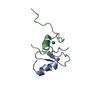
| |||||||||
|---|---|---|---|---|---|---|---|---|---|---|
| 1 |
| |||||||||
| NMR ensembles |
|
- Components
Components
| #1: Protein/peptide | Mass: 5199.939 Da / Num. of mol.: 1 / Fragment: GNF Source method: isolated from a genetically manipulated source Source: (gene. exp.)   |
|---|---|
| #2: Protein/peptide | Mass: 3961.636 Da / Num. of mol.: 1 / Fragment: USF1 Source method: isolated from a genetically manipulated source Source: (gene. exp.)   |
| #3: Chemical |
-Experimental details
-Experiment
| Experiment | Method: SOLUTION NMR | ||||||||||||||||||||||||||||||||||||||||||||
|---|---|---|---|---|---|---|---|---|---|---|---|---|---|---|---|---|---|---|---|---|---|---|---|---|---|---|---|---|---|---|---|---|---|---|---|---|---|---|---|---|---|---|---|---|---|
| NMR experiment |
| ||||||||||||||||||||||||||||||||||||||||||||
| NMR details | Text: Other commonly used standard triple-resonance NMR experiments were also recorded. |
- Sample preparation
Sample preparation
| Details |
| |||||||||||||||
|---|---|---|---|---|---|---|---|---|---|---|---|---|---|---|---|---|
| Sample conditions | pH: 5.5 / Pressure: ambient / Temperature: 280 K |
-NMR measurement
| Radiation | Protocol: SINGLE WAVELENGTH / Monochromatic (M) / Laue (L): M |
|---|---|
| Radiation wavelength | Relative weight: 1 |
| NMR spectrometer | Type: Bruker DRX / Manufacturer: Bruker / Model: DRX / Field strength: 600 MHz |
- Processing
Processing
| NMR software |
| ||||||||||||||||||||||||
|---|---|---|---|---|---|---|---|---|---|---|---|---|---|---|---|---|---|---|---|---|---|---|---|---|---|
| Refinement | Method: simulated annealing, molecular dynamics torsion angle dynamics Software ordinal: 1 Details: Standard triple-resonance NMR spectroscopy was first used to determine the preliminary structure of the complex. Since the backbone folds of both GNF and USF1 did not appear to be ...Details: Standard triple-resonance NMR spectroscopy was first used to determine the preliminary structure of the complex. Since the backbone folds of both GNF and USF1 did not appear to be substantially altered to those of the proteins in isolation, the computer program Haddock was used to dock the two partner proteins using intermolecular NOEs obtained from double half-filtered NOESY experiments, and ambiguous restraints derived from mutagenesis and NMR titration experiments. | ||||||||||||||||||||||||
| NMR representative | Selection criteria: lowest energy | ||||||||||||||||||||||||
| NMR ensemble | Conformer selection criteria: structures with the lowest energy Conformers calculated total number: 100 / Conformers submitted total number: 20 |
 Movie
Movie Controller
Controller





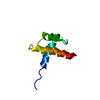
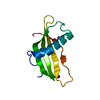



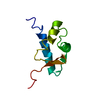

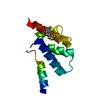

 PDBj
PDBj









 HNCA
HNCA